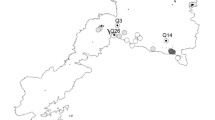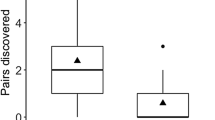Abstract
Pteropodids like the Indian flying fox roost gregariously and externally in tree canopies. In such conditions, hierarchy and competition for preferred roosting positions may result in the social structuring of animal aggregation. Vigilance is a manifestation of competition in canopy roosting bats, which can vary temporally, and according to the spatial position. The current study investigated the function of vigilance in terms of environmental vigilance (anti-predatory) and social vigilance. We expect the extent of vigilance to be influenced by the relative spatial position of the bat. Furthermore, we expect neighboring roost tree density to affect vigilance too. Pteropus giganteus showed varying levels of vigilance according to roosting architecture. Across all positions, on average, they spent 7% of their roosting time being vigilant. Peripheral bats on a roosting tree showed a significant increase in environmental vigilance compared to the core, thus confirming the edge effect hypothesis. Bats, however, displayed no significant variation concerning social vigilance as roosting positions were observed in the periphery and core. Also, neighbor roost tree density did not impact vigilance. Overall, we see that a spatial vigilance architecture prevails in a roosting tree. Plus, the very persistence of vigilance while day roosting/resting in huge numbers indicates a potential fitness advantage.
Significance statement
As bats spend over half their lives roosting, it is assumed that selective pressures of their roosting environment may have played a crucial role in their evolution, behavior, and ecology. Generally, the bats’ primary objective at roosts is resting, followed by social behavior and other maintenance activities. The major gap in terms of Indian flying foxes lies in their roosting architecture and environmental relations. In this study, we find an architectural design in the way bats roost and display their vigilance. The study points out that the main essence of vigilance theory is prevalent in Indian flying foxes. Total vigilance increased from core to periphery, which may reflect the existence of a risk gradient. Flying fox colonies have complex social organization and are highly structured.



Similar content being viewed by others
Data availability
The authors confirm that all relevant data are included in the article and its supplementary information files. The authors declare that data supporting the findings of this study are available within the report.
References
Altmann J (1974) Observational study of behavior: sampling methods. Behaviour 49:227–266. https://doi.org/10.1163/156853974X00534
Beauchamp G (2015) Animal vigilance: monitoring predators and competitors. Academic Press, San Diego
Brighton CH, Zusi L, McGowan KA, Kinniry M, Kloepper LN, Taylor GK (2021) Aerial attack strategies of hawks hunting bats, and the adaptive benefits of swarming. Behav Ecol 32:464–476. https://doi.org/10.1093/beheco/araa145
Brooks ME, Kristensen K, van Benthem KJ, Magnusson A, Berg CW, Nielsen A, Skaug HJ, Mächler M, Bolker BM (2017) glmmTMB balances speed and flexibility among packages for zero-inflated generalized linear mixed modeling. R J 9:378–400. https://doi.org/10.32614/RJ-2017-066
Brünnich MT (1782) Dyrenes Historie og Dyre-Samlingen udi Universitetets Natur-Theater. Trykt hos Hofbogtrykker Nicolaus Moller, pp 45–48
Bumann D, Rubenstein D, Krause J (1997) Mortality risk of spatial positions in animal groups: the danger of being in the front. Behaviour 134:1063–1076. https://doi.org/10.1163/156853997X00403
Caine NG, Marra SL (1988) Vigilance and social organization in two species of primates. Anim Behav 36:897–904. https://doi.org/10.1016/S0003-3472(88)80172-6
Cameron EZ, du Toit JT (2005) Social influences on vigilance behaviour in giraffes, Giraffacamelopardalis. Anim Behav 69:1337–1344. https://doi.org/10.1016/j.anbehav.2004.08.015
Champion HG, Seth SK (1968) A revised survey of the forest types of India. Manager of publications, Delhi, Government of India
Childress MJ, Lung MA (2003) Predation risk, gender and the group size effect: does elk vigilance depend upon the behaviour of conspecifics? Anim Behav 66:389–398. https://doi.org/10.1006/anbe.2003.2217
Colagross A, Cockburn A (1993) Vigilance and grouping in the Eastern gray kangaroo, Macropusgiganteus. Aust J Zool 41:325–334. https://doi.org/10.1071/ZO9930325
Danchin E, Giraldeau L-A, Valone TJ, Wagner RH (2004) Public information: from nosy neighbors to cultural evolution. Science 305:487–491. https://doi.org/10.1126/science.1098254
Das P (2019) Vigilance architecture and temporal variation in emergence-return of a keystone bat: the Indian flying fox (Pteropus giganteus). MSc thesis, Wildlife Institute of India
Di Blanco Y, Hirsch BT (2006) Determinants of vigilance behavior in the ring-tailed coati (Nasuanasua): the importance of within-group spatial position. Behav Ecol Sociobiol 61:173–182. https://doi.org/10.1007/s00265-006-0248-3
Douma JC, Weedon JT (2019) Analysing continuous proportions in ecology and evolution: a practical introduction to beta and Dirichlet regression. Methods Ecol Evol 10:1412–1430. https://doi.org/10.1111/2041-210X.13234
Elgar MA (1989) Predator vigilance and group size in mammals and birds: a critical review of the empirical evidence. Biol Rev 64:13–33. https://doi.org/10.1111/j.1469-185X.1989.tb00636.x
Elgar MA, Catterall CP (1981) Flocking and predator surveillance in house sparrows: test of an hypothesis. Anim Behav 29:868–872. https://doi.org/10.1016/S0003-3472(81)80022-X
Evans JC, Votier SC, Dall SRX (2016) Information use in colonial living. Biol Rev 91:658–672. https://doi.org/10.1111/brv.12188
Hall LS, Richards G (2000) Flying foxes: fruit and blossom bats of Australia. University of New South Wales Press, Sydney
Hamilton WD (1971) Geometry for the selfish herd. J Theor Biol 31:295–311. https://doi.org/10.1016/0022-5193(71)90189-5
Han L, Blank D, Wang M, Yang W (2020) Vigilance behaviour in Siberian ibex (Capra sibirica): effect of group size, group type, sex and age. Behav Process 170:104021. https://doi.org/10.1016/j.beproc.2019.104021
Harten L, Matalon Y, Galli N, Navon H, Dor R, Yovel Y (2018) Persistent producer-scrounger relationships in bats. Sci Adv 4:e1603293. https://doi.org/10.1126/sciadv.1603293
Hartig F (2022) DHARMa: Residual diagnostics for hierarchical (multi-level/mixed) regression models. R package version 0.4.6, https://CRAN.R-project.org/package=DHARMa
Hirsch B (2002) Social monitoring and vigilance behavior in brown capuchin monkeys (Cebusapella). Behav Ecol Sociobiol 52:458–464. https://doi.org/10.1007/s00265-002-0536-5
Jones ME (1998) The function of vigilance in sympatric marsupial carnivores: the eastern quoll and the Tasmanian devil. Anim Behav 56:1279–1284. https://doi.org/10.1006/anbe.1998.0893
Kassambara A (2022) ggpubr: ‘ggplot2’ based publication ready plots. R package version 0.5.0, https://CRAN.R-project.org/package=ggpubr
Klose SM, Welbergen JA, Goldizen AW, Kalko EKV (2009) Spatio-temporal vigilance architecture of an Australian flying-fox colony. Behav Ecol Sociobiol 63:371–380. https://doi.org/10.1007/s00265-008-0671-8
Koilraj BJ, Agoramoorthy G, Marimuthu G (2001) Copulatory behaviour of Indian flying fox Pteropusgiganteus. Curr Sci 80:15–16
Krause J, Ruxton GD (2002) Living in groups. Oxford University Press, New York
Kumar R, Prasad DN, Elangovan V (2019) The effect of seasonal changes on emergence behaviour of the Indian flying fox, Pteropusgiganteus. Proc Zool Soc 72:74–78. https://doi.org/10.1007/s12595-018-0269-8
Kunz TH (1982) Roosting ecology of bats. In: Kunz TH (ed) Ecology of bats, 1st edn. Plenum press, New York, pp 1–55
Kunz TH, Robson SK, Nagy KA (1998) Economy of harem maintenance in the greater spear-nosed bat, Phyllostomushastatus. J Mammal 79:631–642. https://doi.org/10.2307/1382993
Li C, Jiang Z, Li L, Li Z, Fang H, Li C, Beauchamp G (2012) Effects of reproductive status, social rank, sex and group size on vigilance patterns in Przewalski’s gazelle. PLoS ONE 7:e32607. https://doi.org/10.1371/journal.pone.0032607
Lima SL (1995) Back to the basics of anti-predatory vigilance: the group-size effect. Anim Behav 49:11–20. https://doi.org/10.1016/0003-3472(95)80149-9
Lima SL, Zollner PA, Bednekoff PA (1999) Predation, scramble competition, and the vigilance group size effect in dark-eyed juncos (Junco hyemalis). Behav Ecol Sociobiol 46:110–116. https://doi.org/10.1007/s002650050599
Markus N, Blackshaw JK (2002) Behaviour of the black flying fox Pteropusalecto : 1. An ethogram of behaviour, and preliminary characterisation of mother-infant interactions. Acta Chiropterol 4:137–152. https://doi.org/10.3161/001.004.0203
McConkey KR, Drake DR (2006) Flying foxes cease to function as seed dispersers long before they become rare. Ecology 87:271–276. https://doi.org/10.1890/05-0386
McFarland D (ed) (1987). Oxford University Press, New York
Mosca Torres ME, Puig S, Novillo A, Ovejero R (2015) Vigilance behaviour of the year-round territorial vicuña (Vicugnavicugna) outside the breeding season: influence of group size, social factors and distance to a water source. Behav Process 113:163–171. https://doi.org/10.1016/j.beproc.2015.02.006
Neuweiler G (1969) Verhaltensbeobachtungen an einer indischen Flughundkolonie (Pteropus g. giganteus Brünn)0.1. Z Tierpsychol 26:166–199. https://doi.org/10.1111/j.1439-0310.1969.tb01944.x
Pays O, Jarman PJ (2008) Does sex affect both individual and collective vigilance in social mammalian herbivores: the case of the eastern grey kangaroo? Behav Ecol Sociobiol 62:757–767. https://doi.org/10.1007/s00265-007-0501-4
Pays O, Sirot E, Fritz H (2012) Collective vigilance in the greater kudu: towards a better understanding of synchronization patterns. Ethology 118:1–9. https://doi.org/10.1111/j.1439-0310.2011.01974.x
Périquet S, Todd-Jones L, Valeix M et al (2012) Influence of immediate predation risk by lions on the vigilance of prey of different body size. Behav Ecol 23:970–976. https://doi.org/10.1093/beheco/ars060
Rahman A, Choudhury P (2017) Status and population trend of chiropterans in Southern Assam India. Biodiversity Int J 1:121–132. https://doi.org/10.15406/bij.2017.01.00018
Roberts G (1996) Why individual vigilance declines as group size increases. Anim Behav 51:1077–1086. https://doi.org/10.1006/anbe.1996.0109
Rose LM, Fedigan LM (1995) Vigilance in white-faced capuchins, Cebuscapucinus, in Costa Rica. Anim Behav 49:63–70. https://doi.org/10.1016/0003-3472(95)80154-5
RStudio Team (2020). RStudio: integrated development for R. RStudio Inc., Boston, MA, http://www.rstudio.com/
Schaller GB (2009) The deer and the tiger: a study of wildlife in India. University of Chicago Press, Chicago
Shi J, Li D, Xiao W (2011) Influences of sex, group size, and spatial position on vigilance behavior of Przewalski’s gazelles. Acta Theriol 56:73–79. https://doi.org/10.1007/s13364-010-0001-1
Silbernagel E (2005) Pteropus giganteus. Animal Diversity Web, https://animaldiversity.org/accounts/Pteropus_giganteus/
Smith SM, Cain JW III (2009) Foraging efficiency and vigilance behaviour of impala: the influence of herd size and neighbour density. Afr J Ecol 47:109–118. https://doi.org/10.1111/j.1365-2028.2008.01014.x
Stojan-Dolar M, Heymann EW (2010) Vigilance in a cooperatively breeding primate. Int J Primatol 31:95–116. https://doi.org/10.1007/s10764-009-9385-7
Treves A (2000) Theory and method in studies of vigilance and aggregation. Anim Behav 60:711–722. https://doi.org/10.1006/anbe.2000.1528
Tsang SM (2020) Pteropus giganteus (errata version published in 2021). The IUCN Red List of Threatened Species 2020:e.T18725A194134899
Ward A, Webster M (2016) Sociality: the behaviour of group-living animals. Springer International Publishing, Cham
Zhao J, Lyu N, Sun Y, Zhou L (2019) Number of neighbors instead of group size significantly affects individual vigilance levels in large animal aggregations. J Avian Biol 50:jav.02065. https://doi.org/10.1111/jav.02065
Zhao J-M, Lyu N, Cheng W, Zhou L-Z (2020) Cryptic competition from neighbours significantly reduces intake rate of foraging greater white-fronted geese. Anim Behav 167:119–126. https://doi.org/10.1016/j.anbehav.2020.07.011
Acknowledgements
The authors thank the Dean and Director of the Wildlife Institute of India for their support. We also thank Pranjal Bhattacharjee, Debolina Nath, Devasish Goala, Syed Amjad Ahmed, and Prasanta Das for volunteering in the data collection. The active help and cooperation from localites of study site villages, with special mention of Bijon Kumar Barbhuiya and Ribhendu Shekhar Das of Rengti, Shudhangshu Roy of Bethukandi, and Bhulashonkor Das Lashkar of Dulalgram, is highly appreciated. Thanks also to Harish Prakash and Keshab Gogoi, for helping us with the analysis. Finally, we thank our reviewers whose remarks greatly increased the quality of the paper.
Author information
Authors and Affiliations
Contributions
Pratik Das, Salvador Lyngdoh, and Surendra Prakash Goyal conceived the study. Pratik Das collected the data and analyzed the data. Salvador Lyngdoh and Pratik Das, drafted the manuscript (MS). Salvador Lyngdoh and Surendra Prakash Goyal wrote, reviewed, and approved the MS. Pratik Das revised the MS.
Corresponding author
Ethics declarations
Ethical approval
The use of animals adheres to the guidelines set forth by the Animal Behavior Society/Association for the Study of Animal Behaviour. No animal was harmed or handled during this study. All observations were made with no physical contact. Hence, ethical approval from the ethics committee was not required in this study.
Conflict of interest
The authors declare no competing interests.
Additional information
Communicated by: M. Knoernschild
Publisher's note
Springer Nature remains neutral with regard to jurisdictional claims in published maps and institutional affiliations.
Supplementary Information
Below is the link to the electronic supplementary material.
Rights and permissions
Springer Nature or its licensor (e.g. a society or other partner) holds exclusive rights to this article under a publishing agreement with the author(s) or other rightsholder(s); author self-archiving of the accepted manuscript version of this article is solely governed by the terms of such publishing agreement and applicable law.
About this article
Cite this article
Das, P., Goyal, S.P. & Lyngdoh, S. Spatial vigilance architecture of Indian flying fox colonies in rural parts of Barak Valley, Northeast India. Behav Ecol Sociobiol 77, 66 (2023). https://doi.org/10.1007/s00265-023-03329-3
Received:
Revised:
Accepted:
Published:
DOI: https://doi.org/10.1007/s00265-023-03329-3




